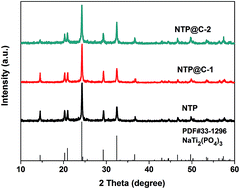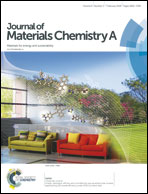Porous carbon-coated NaTi2(PO4)3 with superior rate and low-temperature properties†
Abstract
Nanosized porous carbon-coated NaTi2(PO4)3 (NTP) particles with superior rate and low-temperature properties are synthesized by a hydrothermal process combined with different carbon coating steps. Their structures and electrochemical performances are analyzed by X-ray diffraction, scanning/transmission electron microscopies, Raman spectroscopy, N2 adsorption/desorption measurement and galvanostatic cell cycling. The optimized carbon-coated NTP sample NTP@C-2 shows superb rate performance with a charge capacity of 110.9 mA h g−1 at 30C rate, i.e. 97.0% retention of its capacity at 0.5C. After 1000 cycles at 10C, the reversible capacity can still reach 105.6 mA h g−1 with a very slow capacity decay of 0.0022% per cycle. Even at −20 °C, NTP@C-2 can still deliver a capacity of 97.6 mA h g−1 at 10C and 61.1 mA h g−1 at 20C. These excellent electrochemical performances can be attributed to both the nanosized porous architecture and the highly graphitic carbon coating. The use of a small amount of Na3V2(PO4)3 intermediate powder accounts for the formation of more sp2-type carbon coating. Such an NTP powder provides a promising anode material for high power sodium-ion batteries.



 Please wait while we load your content...
Please wait while we load your content...